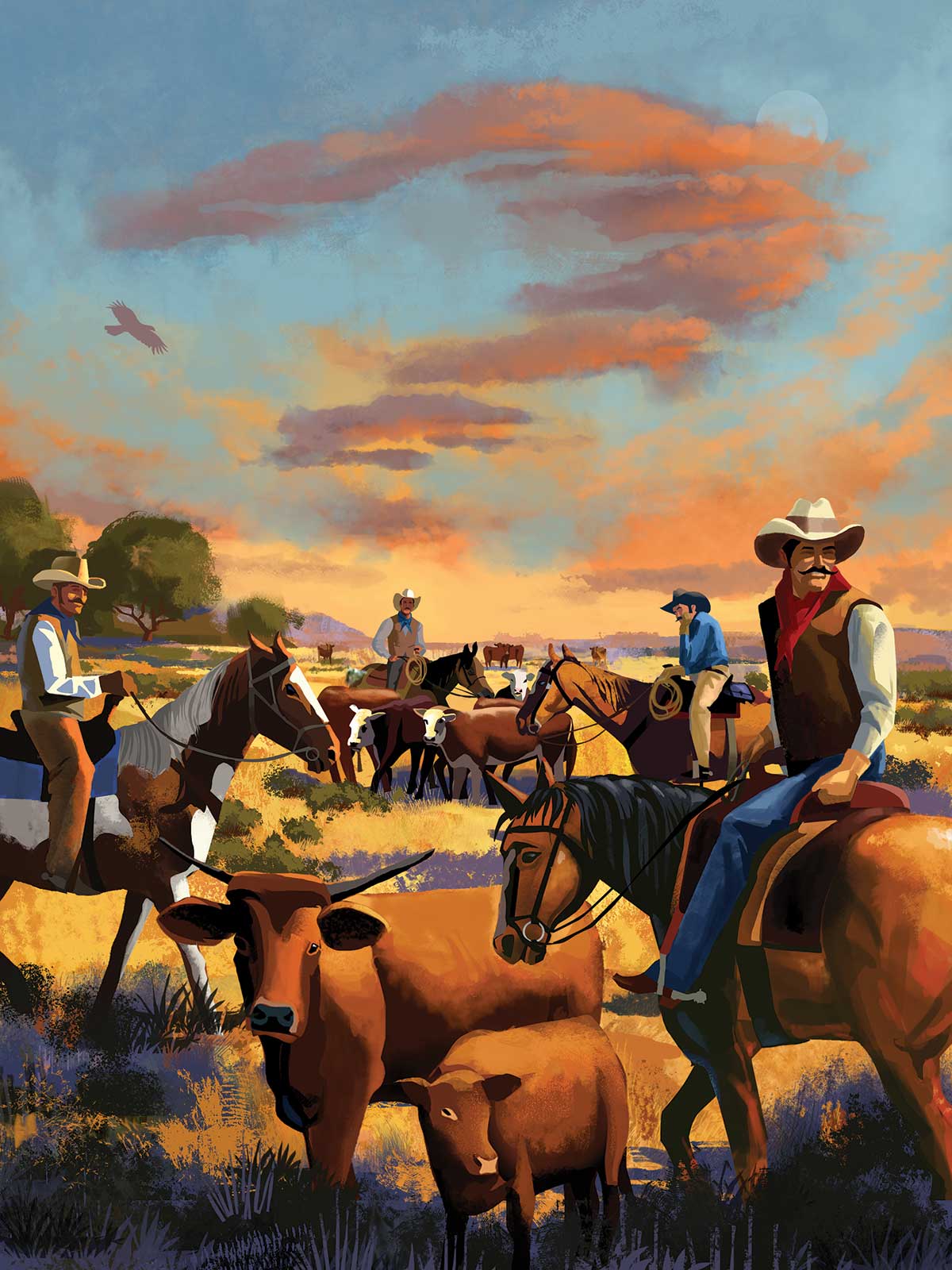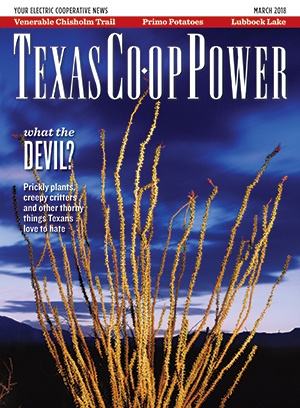Few place names evoke the spirit of Texas and the Old West more than the storied Chisholm Trail. The very words make me hear spurs a-jingle-janglin’ and yippie-ti-yi-yos a-yodelin’. Last year, folks up and down the trail celebrated its 150th anniversary.
What most Texans might not know is that the Chisholm Trail never existed in Texas. The story made its best-documented appearance at the Real Chisholm Trail Symposium, held last May in Saint Jo. That’s when Wayne Ludwig, founder of the Facebook-only Texas Cattle Trails History Group, who confessed to being a little nervous at the time, officially broke the story.
Hold your horses! That’s pretty much like forgetting the Alamo. Trying to buy tickets to a Cowboys home game in Dallas, Georgia. Asking the band to play Ernest Tubb’s timeless tune, Waltz Across Rhode Island.
After all, the Lone Star State just about has more things named for the Chisholm Trail than it does cattle. From skateparks to quilt guilds and dental clinics—if it’s a thing, somebody in Texas has named it for the Chisholm Trail. Still, Ludwig reported finding scant evidence that the term was used in Texas before the days of singing cowboys and Western movies.
Symposium speaker Tom B. Saunders IV, a rancher and historian whom I would honor with the title of old-timer, provided a living link to the cattle-drive era. Saunders’ great-great-uncle, George W. Saunders, went up the trail with several herds in the 1870s and later founded the Trail Drivers Association. In 1931, the association adopted a formal resolution declaring that “the Chisholm Trail proper crossed the Red River at the community known as Red River Station and extended north to Abilene” in Kansas and that “the herds originating at all points in Texas drove north over the western or eastern Texas-Kansas cattle trails.”
I’m not sure that Shakespeare’s dog-eared maxim, “A rose by any other name would smell as sweet,” would apply to a cattle trail. Though most folks in Saint Jo, about 11 miles from the Red River, agree with the Trail Drivers Association, there’s no need to chisel “Chisholm” off trail markers and other signage that has acquired the name through a century of regional tradition. The association offered its resolution “merely in the interest that Texas history may be properly preserved to posterity.”
Or as Ludwig expressed it in his talk, quoting a proverb from the film, The Man Who Shot Liberty Valance, “This is the West, sir. When the legend becomes fact, print the legend.”
Nomenclature aside, everyone agrees that the main cattle-drive era started after the Civil War and lasted a couple of decades, and that Texas cowboys and cowgirls escorted millions of cattle to shipping points in Kansas. Most histories say that the trail north of the Red River was named for the Indian trader Jesse Chisholm. Others have speculated it was named for Denton County cowman John Chisum. Some say it should be called the Black Beaver Trail, for a Delaware scout who led Union soldiers out of the Indian Territory during the Civil War and showed the trail to Chisholm.
It’s almost easier to name a spot through the middle of Texas that isn’t associated with the Chisholm Trail than to cite all the spots that celebrate their role in the trail’s legacy. We’ll mosey ’round a few sites along the trail and its feeder routes—with apologies to any we might miss.
Down in the Rio Grande Valley, the Donna Hooks Fletcher Historical Museum in Donna has exhibits about the town’s role as “an early pass-through on the Chisholm Trail,” according to the Texas Historical Commission. A historical marker commemorates Chisholm booster P.P. Ackley, who cowboyed up the trail in 1878. In the 1930s, as a winter Texan based in Donna, he placed cast-iron and granite markers from Kansas to the Rio Grande. Historians say Ackley had many of his facts wrong, but you can’t fault his style and enthusiasm. A sign outside his Donna home read “End of the Chisholm Trail,” and neighbors long recalled his handlebar mustache, chaps and the longhorns mounted on his Chrysler coupe.
The Chisholm Trail Heritage Museum in Cuero makes a good case for the 150th birthday falling a year earlier, in 2016, and for a local cowpoke providing the trail’s name. Trail boss Thornton Chisholm headed north from Cardwell Flats, a DeWitt County trading post and stagecoach stop, April 1, 1866, with 30 cowboys and 1,800 rangy longhorns. It took the drovers seven months to reach the railhead at St. Joseph, Missouri.
Some accounts have the Chisholm Trail starting in San Antonio, where the Witte Museum features the George West Trail Drivers Gallery and the courtyard Trail Drivers Monument. Others point to Lockhart, where the Caldwell County Museum exhibits a gallery of Chisholm Trail cowboys. Descendants of Lockhart cattleman John Jacob Myers have passed down oral testimony from other trail drivers that the Texas leg of the Chisholm maybe should be called the Myers Trail.
Learn about Lizzie Johnson Williams, who took her own herd up the Chisholm, at the Hays County Museum in San Marcos’ 1909 Hays County Courthouse. At Round Rock, a bronze sculpture in Chisholm Trail Crossing Park titled The Pioneer Woman pays tribute to trail driver Hattie Cluck. Seventeen storytelling bronze panels make up the Chisholm Trail Monument at the Bell County Museum in Belton.
Drovers herding 25 longhorns in the bronze sculpture park at the Brazos River in Waco include a Mexican vaquero and an African-American cowboy. You can walk out on the 1870 Waco Suspension Bridge and imagine the herds clattering across, a nickel per head. The famous cowboy song collector John Lomax grew up near the trail in Meridian, and some of his papers are archived at the Bosque County Collection.
The Chisholm Trail Outdoor Museum in Cleburne brings pioneer days to life on a 10-acre site where drovers camped. An immense Chisholm Trail Mural at Sundance Square in downtown Fort Worth prepares visitors for the “real thing” in the Fort Worth Stockyards Historic District, where cowboys “drive” cattle on East Exchange Avenue twice daily.
In 2015, the Denton County Trail Marking Committee concluded that the trail ran through the western part of the county. Jack Waide of Bolivar said, “My grandfather, Joe Dillon Waide, told me that he watched cattle drives pass by that were sometimes over a mile wide and took all day to pass by while he was sitting on the front porch.”
Steel sculptures of cowboys and longhorns recall the drives at Chisholm Trail Memorial Park in Bowie. The 1873 Stonewall Saloon in Saint Jo served rye whiskey to many a trailhand. Cowboys also could cut loose in Spanish Fort, now somewhat of a ghost town, before crossing to Indian Territory at Red River Station. Drovers could order a new pair of boots from H.J. Justin in Spanish Fort from 1879 to 1889, when he moved to Nocona.
They needed good boots. They weren’t just sashaying up and down a cow path, pilgrim; they were on the Chisholm Trail. “Most of those boys didn’t make but one trip,” Saunders said. “And once they got home alive, they were so tickled to be back that they didn’t want to risk it again.”
Gene Fowler is an Austin writer who specializes in history.


